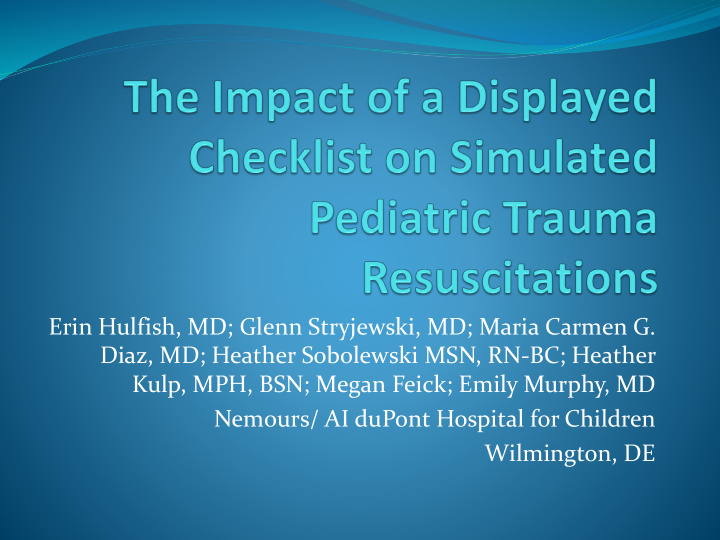



Erin Hulfish, MD; Glenn Stryjewski, MD; Maria Carmen G. Diaz, MD; Heather Sobolewski MSN, RN-BC; Heather Kulp, MPH, BSN; Megan Feick; Emily Murphy, MD Nemours/ AI duPont Hospital for Children Wilmington, DE
Disclosures There are no financial disclosures
Introduction Pediatric trauma resuscitations are fast paced and often chaotic Multiple team members involved from varying disciplines Communication may be effected and result in missed information May lead to compromise in patient care and medical error
1978 the Advanced Trauma Life Support (ATLS) protocol was developed Adherence to guidelines has been shown to decrease morbidity and mortality Despite guidelines there are still omissions May result in patient injury Poor outcomes
Checklists Role of checklists Improve communication Improve completion of tasks Recent studies regarding handheld checklist for trauma resuscitations Improve adherence to guidelines Reduce omissions Improve time to completion of tasks
Objective The primary purpose of our study is to determine if a displayed checklist improves the time to completion of tasks during pediatric trauma resuscitations Secondary purpose is to determine if a displayed checklist improves the absolute completion of tasks of the primary and secondary survey Tertiary purpose is to determine if a displayed checklist decreases effect on workload
Methods Scenarios were created following ATLS core competencies Study broken into three arms One without a checklist One with the team leader using a handheld checklist One with the checklist displayed on a monitor visible to all team members
Time to Completion of Surveys
Omission of Tasks
Conclusion There was no significant decrease in time to completion of tasks during the primary or secondary survey with the use of the checklist There was a significant decrease in the number of tasks omitted during the primary and secondary survey with use of the displayed checklist
References Arriaga, AF; et al. “Simulation -based Trial of Surgical- Crisis Checklists.” The New England Journal of Medicine 2013; 368: 246-53 Carter, EA. et al. “Adherence to ATLS Primary and Secondary Surveys During Pediatric Trauma Resuscitation”. Resuscitation. 2013;84: 66-71 Harrison TK; et al. “Use of Cognitive Aids in Simulated Anesthetic Crisis”. Anesthesia Annals 2006; 103:551-6 Kelleher, DC. et al; “Effect of a Checklist on Advanced Trauma Life Support Task Performance During Pediatric Trauma Resuscitation”. Academic Emergency Medicine 2014;21: 1129-1134 Parsons, SE; et al “Improving ATLS Performance in Simulated Pediatric Trauma Resuscitation Using a Checklist.” Ann of Surg 2013; 259(4): 807-813 Ritchie,PD. Cameron, PA. “An Evaluation of Trauma Team Leader Performance by Video Recording”. Australian New Zealand Journal Surgery. 1999;69: 183-86 Spanjersberg , WR; et al “ Protocol Compliance and Time Management in Blunt Trauma Resuscitation.” Journal of Emergency Medicine. 2009; 26:23-27
Questions
Recommend
More recommend